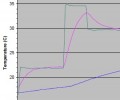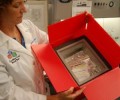You are here
News
2013
Dec 2013 It's hard for me to remember exactly what was going on inside my head almost four years ago when I first saw an advertisement for cord blood banking. That was three children and a lifetime ago. I was a different person. I wasn't a mother yet. I had never nursed, budgeted for child care, disciplined a child of my own, bought kid's apps for my iPhone, or gone days (Weeks? Months? Years?) without a good night's rest. Nevertheless, cord blood banking advertising is designed to elicit a visceral reaction in parents-to-be, and it still has that effect on me now even after all the time and effort I have invested in educating myself on the subject. People are irrational and emotional, especially when dealing with fear, money, or children. Cord blood banking involves all three of these!
Dec 2013 Cords4LifeUK was founded in memory of a British toddler named Charlie Harris - Beard. In April 2011 at the age of 11 months, Charlie was diagnosed with Acute Myeloid Leukaemia (AML), and within the next four months he went through four intensive cycles of chemotherapy to suppress his blood cancer. But AML cannot be cured without a stem cell transplant, and unless he could find a matching donor, Charlie was given only three months to live.
Dec 2013 I did not set out to write a novel about cord blood. I stumbled upon the idea in an unlikely place - a book club, where I'd been invited to speak about my first novel, HOME REPAIR. I mentioned that I'd been thinking about my second novel, a much darker novel than the first one, more complicated. In fact, I told the group, I'd been thinking about it for 30 years. But I was stuck on a plot point.
Nov 2013
Any temperature extremes that would threaten the life of a child or a pet - being left in a parked car for more than a few minutes, traveling in the cargo hold of an airplane, etc. - also kills cord blood stem cells. The key to shipping fresh cord blood to the laboratory with maximum cell survival is to keep the temperature stable inside the shipping kit. But this simple requirement can be very challenging to implement.
Nov 2013 Figure 1: Collection kits for cord blood public donation
MD Anderson cord blood bank
Nov 2013 You might be asking "Just what is pelvic organ prolapse, or POP?" POP is when the bladder, and/or bowel, and/or uterus herniates into the vagina. Twenty five percent of all women have one or more symptoms of POP: urinary or bowel incontinence and sexual dysfunction - this is why it is a taboo subject - the symptoms are so embarrassing.
POP mainly results from pregnancy and injury associated with vaginal birth, particularly after prolonged second stage labour or the use of forceps. Delivering a large baby and having an episiotomy can also cause POP. POP is exacerbated by obesity, ageing, chronic coughing, heavy lifting and straining associated with constipation. Women who deliver their first baby over the age of 30 tend to have more severe POP.
Oct 2013 The Genetics Policy Institute (GPI) is a leading promoter and defender of stem cell research and other cutting-edge medical research targeting cures. We are the catalyst and provide leadership to the Pro-Cures Movement, an influential global network of stakeholders - from patient-advocacy to science and industry.
Oct 2013 Let's say that you are a medical consumer who lives in the United States. We are all medical consumers at some point in our lives. Financially, does it make more sense for you to save your own stem cells for later use, or to assume that you will buy an off-the-shelf stem cell therapy when the time comes that you need one?
Oct 2013
Ivan N. Rich, PhD,
Founder & CEO HemoGenix, Inc.
Sep 2013 Sarah Shaffer, co-founder










